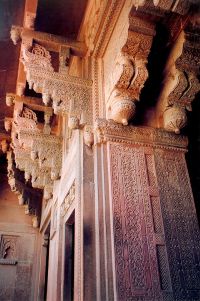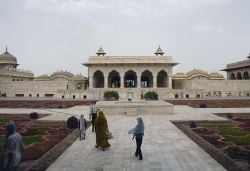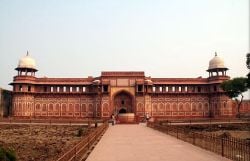Agra Fort
| Agra Fort* | |
|---|---|
| UNESCO World Heritage Site | |
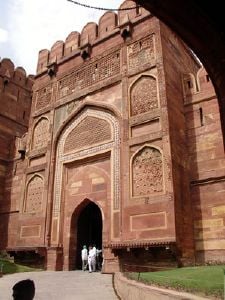
| |
| State Party | |
| Type | Cultural |
| Criteria | |
| Reference | 251 |
| Region** | south asia |
| Inscription history | |
| Inscription | 1983 (7th Session) |
| * Name as inscribed on World Heritage List. ** Region as classified by UNESCO. | |
Agra Fort, a UNESCO World Heritage Site located in Agra, India, has also been known by the names Lal Qila, Fort Rouge and Red Fort of Agra. Situated about 2.5 km northwest of its much more famous sister monument, the Taj Mahal, the fort may be more accurately described as a walled palatial city. As most important fort in India, the great Mughals Babur, Humayun, Akbar, Jehangir, Shah Jahan and Aurangzeb lived and governed the country within the walls. The fort contains the largest state treasury and mint in India. Visited by foreign ambassadors, travellers and the highest dignitaries, Agra Fort witnessed a parade of historically significant persons who participated in the making of history in India.
Agra Fort represents a blend of Hindu and Islamic civilization and architecture. Prior to undergoing an phenomenal remodeling along Islamic lines in the middle 1500s, Agra Fort had been maintained as a stronghold of theHindu government. After the British used Agra Fort as a headquarters and barracks from 1800 to 1860, the structure blended Hindu and Islamic architecture. Unfortunately, the British destroyed many of the 500 original buildings within the fort to make way for quartering and training troops. Fortunately, a few of the original structures of the fort remained standing after their departure, permitting a glimpse at the magnificience of the building enterprise.
History
Originally a brick fort held by the Chauhan Rajputs, historical documents mention Agra for the first time in 1080 C.E. when a Ghaznavide force captured it. Sikandar Lodi (1487-1517), the first Sultan of Delhi who shifted his administration to Agra, lived in the fort. He governed the country from Agra, raising the site to the importance of the second capital. Lodi died in the fort in 1517 and his son, Ibrahim Lodi, defended it for nine years until he was defeated and killed at Panipat in 1526. Ibrahim built several palaces, wells and a mosque during his rule.
After victory at the Battle of Panipat, Mughals captured the fort with its vast treasure, including a large diamond later named the Kohinoor diamond. Babur assumed control of the fort, building a baoli (step well) in it. Humayun, coronated at Agra in 1530, suffered defeat at the Battle of Bilgram in 1530 C.E. Sher Shah held the fort for five years. The Mughals defeated the Afghans, finally, at the Battle of Panipat in 1556 C.E.
Realizing the importance of its central situation, Akbar decided to make it his capital and arrived in Agra in 1558. His historian, Abdul Fazal, recorded Agra as a brick fort known as 'Badalgarh'. In a ruined condition, Akbar rebuilt the structure using red sandstone. Architects laid the foundation, using bricks in the inner core with sandstone on external surfaces. Some 4,000 builders worked on the rebuilding project for eight years, finishing in 1573.
During the reign of Akbar's grandson, Shah Jahan the site finally assumed its present appearance. The legend states that Shah Jahan built the beautiful Taj Mahal for his wife, Mumtaz Mahal. Unlike his grandfather, Shah Jahan tended to have buildings made from white marble, often inlaid with gold or semi-precious gems. He destroyed some of the earlier buildings inside the fort to build new structures.
At the end of his life, Aurangzeb imprisoned his father, Shah Jahan, in the fort—a mild punishment considering the luxury of the fort. Legend states that Shah Jahan died in Muasamman Burj, a tower with a marble balcony with an excellent view of the Taj Mahal.
Agra Fort served as a site of one of the battles during the Indian rebellion of 1857, ending of the British East India Company's rule in India, leading to a century of direct rule of India by Britain.
Layout
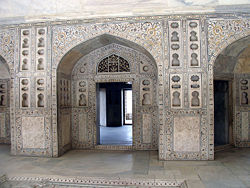
The Agra Fort won the Aga Khan Award for Architecture in the year 2004, India Post issuing a stamp to commemorate that prestigious award on November 28, 2004.
The fort has a semi-circular plan, its chord lying parallel to the river. Its walls stand seventy feet high. Double ramparts have massive circular bastions at regular intervals as well as battlements, embrasures, machicolations and string courses. Four gates provide access on its four sides, one Khizri gate" opening to the river.
Two of the gates, the 'Delhi Gate' and the 'Lahore Gate' (sometimes called Amar Singh Gate), deserve special note.
Most experts and visitor alike consider the Delhi Gate, facing the city, the grandest of the four gates. It leads to an inner gate called the Hathi Pol (Elephant Gate) where two life-sized stone elephants with their riders stand guard. A draw-bridge and a crooked entrance make it impregnable.
The monumental Delhi gate served as the king's formal gate. Because the Indian military (the Parachute Brigade in particular) still uses the northern portion of the Agra Fort, the Delhi Gate has been closed to the public. Tourists enter via the Lahore Gate, so named because it faces Lahore, in Pakistan.
In architectural history, Agra Fort has played an important role. Abul Fazal recorded that five hundred buildings, in the beautiful designs of Bengal and Gujarat, stood in the fort. He demolished some to make way for his white marble palaces. The British destroyed most of the remaining original buildings between 1803 and 1862 while raising barracks. Hardly 30 Mughal buildings have survived on the southeastern side, facing the river. Of those, the Delhi Gate and Akbar Gate and one palace - "Bengali Mahal" - serve as excellent representatives of Akbari buildings.
Jahangir renamed Akbar Gate [[Akbar Darwazza], "Amar Singh Gate." Similar in design to the Delhi gate, both have been constructed using red sandstone. The Bengali Mahal, also built of red sandstone, has been split into "Akbari Mahal" and "Jehagiri Mahal."
Some of the most historically interesting mix of Hindu and Islamic architecture have blended together in Agra Fort's current design. Some of the Islamic decorations feature haraam (forbidden) images of living creatures-dragons, elephants and birds-instead of the usual geometric patterns and calligraphy seen in Islamic surface decoration.
Sites and structures within Agra Fort
- Anguri Bagh - 85 square, geometrically arranged gardens.
- Diwan-i-Am (Hall of Public Audience) - used to as an assembly place to hear petitioners, once housed the Peacock Throne.
- Diwan-i-Khas (Hall of Private Audience) - used to receive kings and dignitary, features black throne of Jehangir.
- Golden Pavilions - beautiful pavilions with roofs shaped like the roofs of Bengali huts.
- Jehangiri Mahal - built by Akbar for his son Jehangir.
- Khas Mahal - white marble palace, one of the best examples of painting on marble.
- Macchi Bhawan (Fish Enclosure) - grand enclosure for harem functions, once had pools and fountains.
- Mina Masjid (Heavenly Mosque)- a tiny mosque; closed to the public.
- Moti Masjid (Pearl Mosque) - a private mosque of Shah Jahan.
- Musamman Burj - a large, octagonal tower with a balcony facing the Taj Mahal.
- Nagina Masjid (Gem Mosque) - mosque designed for the ladies of the court, featuring the Zenana Mina Bazaar (Ladies Bazaar) right next to the balcony, where only female merchants sold wares.
- Naubat Khana (Drum House) - a place where the king's musicians played.
- Rang Mahal - where the king's wives and mistresses lived.
- Shahi Burj - Shah Jahan's private work area
- Shah Jahani Mahal - Shah Jahan's first attempt at modification of the red sandstone palace.
- Sheesh Mahal (Glass Palace) or Shish Mahal - royal dressing room featuring tiny mirror-like glass-mosaic decorations on the walls.
Other notable facts
- Many people confuse the much smaller Red Fort at Delhi with Agra Fort. The Mughals never referred the Delhi Red Fort as a fort; rather, they referred to the structure as the 'Lal Haveli', or the Red Bungalow. The Prime Minister of India addresses the nation from Delhi's Red Fort on August 15, India's Independence Day.
- UNESCO designated the Fort a World Heritage Site in 1983.
- The Agra Fort played a key role in the Sherlock Holmes mystery, The Sign of the Four, by Sir Arthur Conan Doyle.
- Egyptian pop star Hisham Abbas featured the Agra Fort in the hit music video Habibi Da.
- Shivaji, founder of the Marantha empire, came to Agra in 1666 C.E. in accord with the terms of "Purandar Treaty" with Mirza Raje Jaisingh. He met Aurangzeb, emperor of the Mughal Empire, in the Diwan-i-khas. In the audience, his host deliberately placed his guest behind men of lower rank. Insulted, Shivaji stormed out of the imperial audience. Arrested and confined to Jai Sing's quarters on May 12, 1666, Shivaji, imagining dungeons and excecution, escaped on August 17, 1666, in a famously sweet legend. A heroic equestrian statue of Shivaji has been erected outside the fort.
- The fort presents a typical example of the Mughal architecture, displaying the North Indian style of fort construction. In South India, officials commonly constructed forts on sea beds like the one at Bekal in Kerala. [1]
- In the second expansion pack for Age of Empires 3, the Asian Dynasties, the game designers presented Agra fort as one of five wonders of Indian civilization.
Notes
- ↑ for more details Bēkal, Śivānanda. 1999. Bēkalakōṭe ondu cāritrika adhyayana. Kāsaragōḍu: Kannaḍa Sāhitya Pariṣattu, Kēraḷa Gaḍināḍa Ghaṭaka. OCLC: 48057293
ReferencesISBN links support NWE through referral fees
- Husain, Muh. Ashraf. 1937. An historical guide to the Agra fort. OCLC: 66169532
- Klingelhofer, William G. 1985. "The Jahangiri Mahal of Agra Fort tradition and transformation in early Mughal architecture." Thesis (Ph.D.)—Harvard University, 1985. OCLC: 16269782
- Husain, Muhammad Ashraf. 1956. Agra Fort. New Delhi: Govt. of India Press. OCLC: 32446073
- "PRESERVATION: Rhone-Poulenc Foundation aids restoration of Taj Mahal, Agra Fort." Chemical and Engineering News "News Edition" of the American Chemical Society. 76 (16)(1998): 14. OCLC: 86435794
- Zuckerman, Jim. 2003. "TRAVEL LIGHT - Agra Fort, India." Petersen's Photographic 38. OCLC: 95847456
External links
All links retrieved June 16, 2023.
- Agra Fort in UNESCO List.
- Centre to secure world heritage status for Red Fort: Milli Gazette article dated 16 May - 31 May 2004.
- The Taj City: Agra Fort.
| |||||||
| Forts in India |
| Achalgarh • Agra Fort • Allahabad Fort • Amber Fort • Asirgarh • Bandhavgarh Fort • Bassein Fort • Bekal Fort • Belapur Fort • Bhimgarh Fort • Bombay Castle • Castella de Aguada • Chanderi fort • Chandragiri • Chandragiri Fort • Chittorgarh Fort • Daulatabad • Delhi Fort • Dongri Fort • Fort Arnala • Fort St George • Fort William • Gingee Fort • Golkonda • Gohad Fort • Gwalior Fort • Harishchandragad • Hosdurg Fort • Jaigarh Fort • Jaisalmer Fort • Jalore Fort • Junagarh Fort • Kalinjar • Kankwadi • Kolaba Fort • Kumbhalgarh • Lal Kot • Lohagad • Lohagarh Fort • Madh Fort • Mahim Fort • Mandu • Mazagon Fort • Mehrangarh Fort • Murud-Janjira • Nahar Singh Mahal • Nahargarh Fort • Narwar fort • Old Fort, Delhi • Padmadurg • Palakkad Fort • Pallipuram Fort • Panhala • Povval Fort • Pratapgad • Qila Rai Pithora • Raigad • Riwa Fort • Sewri Fort • Shivneri Fort • Sindhudurg • Sinhgad • Sion Hillock Fort • St. Angelo Fort • Sudhagad • Taragarh Fort • Thalassery Fort • Tikona • Tughlaqabad • Udayagiri Fort • Vellore Fort • Worli Fort |
| Emperors: | Babur - Humayun - Akbar - Jahangir - Shah Jahan - Aurangzeb - Lesser Mughals |
| Events: | First battle of Panipat - Second battle of Panipat - Third battle of Panipat |
| Architecture: | Humayun's Tomb - Agra Fort - Badshahi Mosque - Lahore Fort - Red Fort - Taj Mahal - Shalimar Gardens - Pearl Mosque - Bibi Ka Maqbara - See also |
| Adversaries: | Ibrahim Lodhi - Sher Shah Suri - Hemu - Shivaji - Guru Gobind Singh |
Credits
New World Encyclopedia writers and editors rewrote and completed the Wikipedia article in accordance with New World Encyclopedia standards. This article abides by terms of the Creative Commons CC-by-sa 3.0 License (CC-by-sa), which may be used and disseminated with proper attribution. Credit is due under the terms of this license that can reference both the New World Encyclopedia contributors and the selfless volunteer contributors of the Wikimedia Foundation. To cite this article click here for a list of acceptable citing formats.The history of earlier contributions by wikipedians is accessible to researchers here:
The history of this article since it was imported to New World Encyclopedia:
Note: Some restrictions may apply to use of individual images which are separately licensed.
